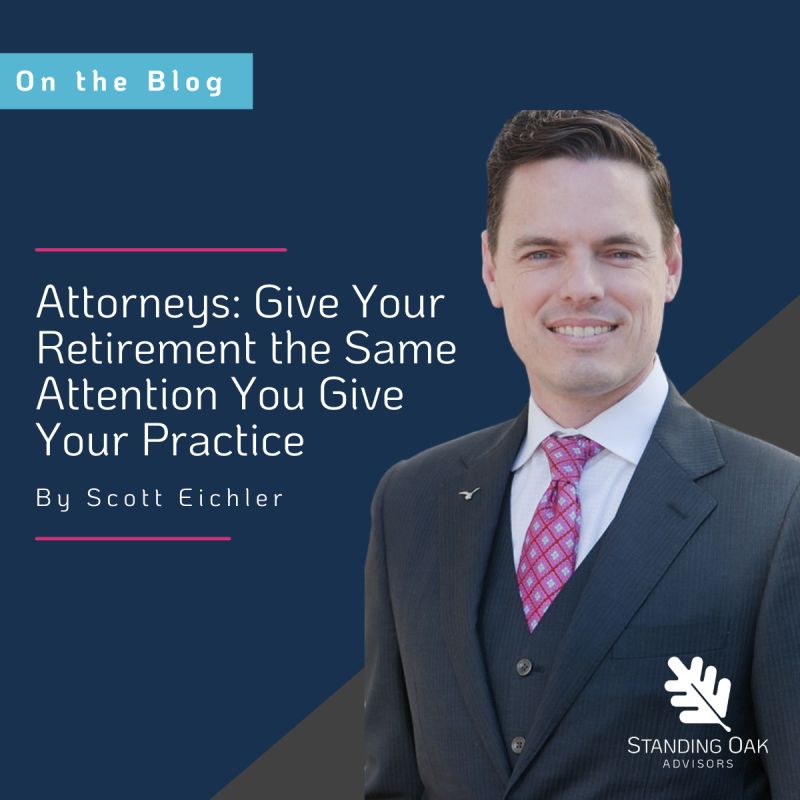Attorneys: Give Your Retirement the Same Attention You Give Your Practice
At Standing Oak, we value your Why. It’s one of the first things we establish with our clients, because it’s crucial to understand the destination before creating a path to reach it. For many attorneys (and professionals in other industries too), the answer to the question of ‘what drives you’ in your business ultimately boils down to building wealth.
In theory, that’s a perfectly clear and distinct goal. But in practical terms, the ways one can approach wealth-building runs the gamut. And it’s no wonder—there are so many sticks used to measure wealth, from the size of a practice to where you went on your last vacation. We propose that a key measurement of true wealth is your ability to retire when and how you want to—perhaps even building a legacy, whether that’s a business, an endowment, or an inheritance.
No matter what your goals are, there are several pitfalls that we sometimes see trap our attorney clients. Here’s what to watch out for, and what to do instead.
Pitfall 1: Dock Picking
Don’t try to predict the future. Instead, consider how you can defer taxes on your long-term savings. There are so many tools that help with that—IRA, Roth, Keogh plans, 401(k), defined benefit plans, to name a few. Which is the right choice? The answer is different case by case. The rules and regulations vary for each, and what’s best in one instance may not be best in another. That’s why there’s no universal wisdom to apply. So put down the crystal ball and stop chasing hints.
Pitfall 2: Lack of Savings
It’s not just about having money saved (although this is a healthy reminder to start saving now if you haven’t yet, and start saving more if you have). The highest value of savings is having a strategy for it. A concrete savings planning makes it possible to get a handle on all potential outcomes. Look ahead to potential obstacles and challenges and orient your planning towards those. Know what tools can help handle a given problem. Make sure your goals are realistic, based on your current savings rate.
Pitfall 3: Life Insurance does not a Retirement Make
Insurance-based pension plans are commonly offered to licensed professionals. They gained popularity because you can often put more money into them than into a typical pension. But there’s a hidden reason for that—commissions, taxes, and fees eat up most of that surplus. On top of that, the benefit you get from your money is not consistent. There are options, such as defined benefit plans, that allow write-offs to ensure you’re not losing half your savings to taxes. Bottom line: life insurance is for if you die, not if you retire.
Pitfall 4: Risk Aversion
Shout it from the rooftops: there’s no such thing as no risk in investment. Anyone offering that line is uninformed or untruthful. Some plans take inflation risk instead of market risk. But that’s not the same thing as risk-free. And sometimes the fees turn out to be higher than the return (another pitfall: not understanding fee structures!).
Pitfall 5: Trying to Do it All
Is it possible to learn everything you need to know about investing and handle all financial planning yourself? Possible, yes. Wise? Maybe not. Think of it this way: as an attorney (or other professional), would you advise your client to represent themselves in a legal proceeding? It’s not impossible, right? But it’s also not advisable—not when there are experts with vast knowledge and practice at their fingertips. That’s a good way to think about working with a financial advisor. Avoid pitfalls and bad choices that could have long-lasting effects. With a few simple data points, your RIA does the heavy lifting on the back end, so you can spend your valuable time doing what you do best—taking care of business.
Ready to take a closer look at your retirement? Schedule a call with us today.


